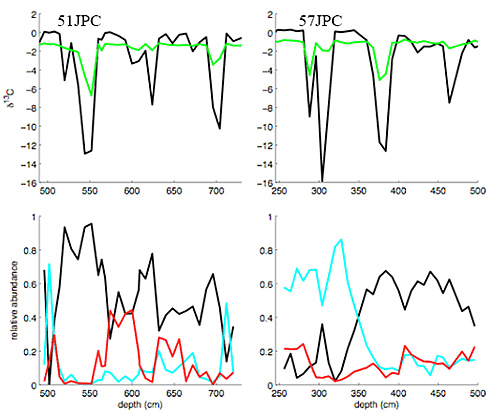Before the geochemistry of methane diagenesis at the Umnak Plateau sites could be fully understood, a firm stratigraphic and chronologic framework in the cores needed to be established. This was accomplished using several methods, including stable isotope ratios of carbon and oxygen in foraminifera, paleomagnetism, and accelerator mass spectrometer (AMS) 14C dating. Sampling from the cores was then based on this stratigraphic framework.
A paleomagnetic study of Umnak Plateau cores, was conducted by Dr. Steve Lund of the University of Southern California. Dr. Lund correlated two cores using, among other techniques, the unique combination of magnetic inclination, declination, and paleointensity, beginning with 51JPC and then continuing with other cores available for analysis. The position of the Laschamp Excursion (a brief reversal in Earth’s magnetic field about 40,000 years ago) in core 51JPC and core 57JPC was established by this work.
Incorporating the paleomagnetic analysis and using core 51JPC as the “type section”, a correlation across all of the cores used in this project was established. Based on this correlation and calculated average sedimentation rate about 150 samples at 10-cm spacing (=200 years) was considered adequate to resolve millennial scale events in the “type section” core and about 100 samples were taken from each of the other cores selected for sampling. In all, about five hundred (500) samples were collected from four (4) cores.
Planktonic foraminifer Neogloboquadrina pachyderma (sinistral) and benthic foraminifer Uvigerina peregrina were selected for subsequent stable isotope analysis and 14C dating. For both cores large negative excursions in δ13C were observed for the sections representing the last glacial maximum. The low δ13C is associated with high δ18O and, upon visual inspection, the foraminifera show evidence of post-depositional overgrowths of authigenic carbonate minerals suggesting a high flux of methane or methane-bearing fluids upward in the sediment column.
The co-PI, Dr. Mea Cook, together with Professor Kai-Uwe Hinrichs at the University of Bremen attempted to isolate archaeol, a biomarker of archaea that perform anaerobic oxidation of methane. The Archaeol were not found in sufficient concentrations to perform isotopic analysis, presumably due to degradation since 2002. Alternatively, the PI was able to isolate another class of compounds; glyceryl dibiphytanyl glyceryl tetraethers (GDGTs), which are produced by all archaea. The isotopic findings using GDGTs provide support that an active microbial community performing anaerobic oxidation of methane in the sediments existed in each episode where authigenic minerals were emplaced. The d13C depletion of these biomarkers occurs in sediments stratigraphically slightly below where authigenic carbonate minerals are present. This is consistent with a vertical flux of pore fluids, which would be the case if there was methane or methane-rich fluid advected upward in the sediment column.
The benthic foraminifera in the core samples are predominantly composed of 6 species. Census counts of the benthic foraminifera during the three stratigraphically highest isotopic excursions in each core were made. It was found that during the isotopic excursions, the relative abundance of Nonionella sp. increases and the relative abundance of U. peregrina and Islandella sp. decrease. These changes in benthic foraminifer species distribution occur in the same depths as the occurrence of authigenic minerals, supporting the idea that the sulfate-methane transition zone was at the seafloor, altering the habitat of the benthic foraminifera while the authigenic minerals were emplaced.

The benthic foraminifer relative abundances (bottom panels) for the three stratigraphically highest isotopic events in core 51JPC (left) and 57JPC (right). The data for U. peregrina, Nonionella sp., and Islandella sp. are plotted in blue, black, and red respectively. For reference, the δ13C stratigraphies are plotted in the top panels, where the black and green lines are the planktonic (N. pachyderma (s.)) and benthic (U. peregrina) foraminifer samples, respectively.




